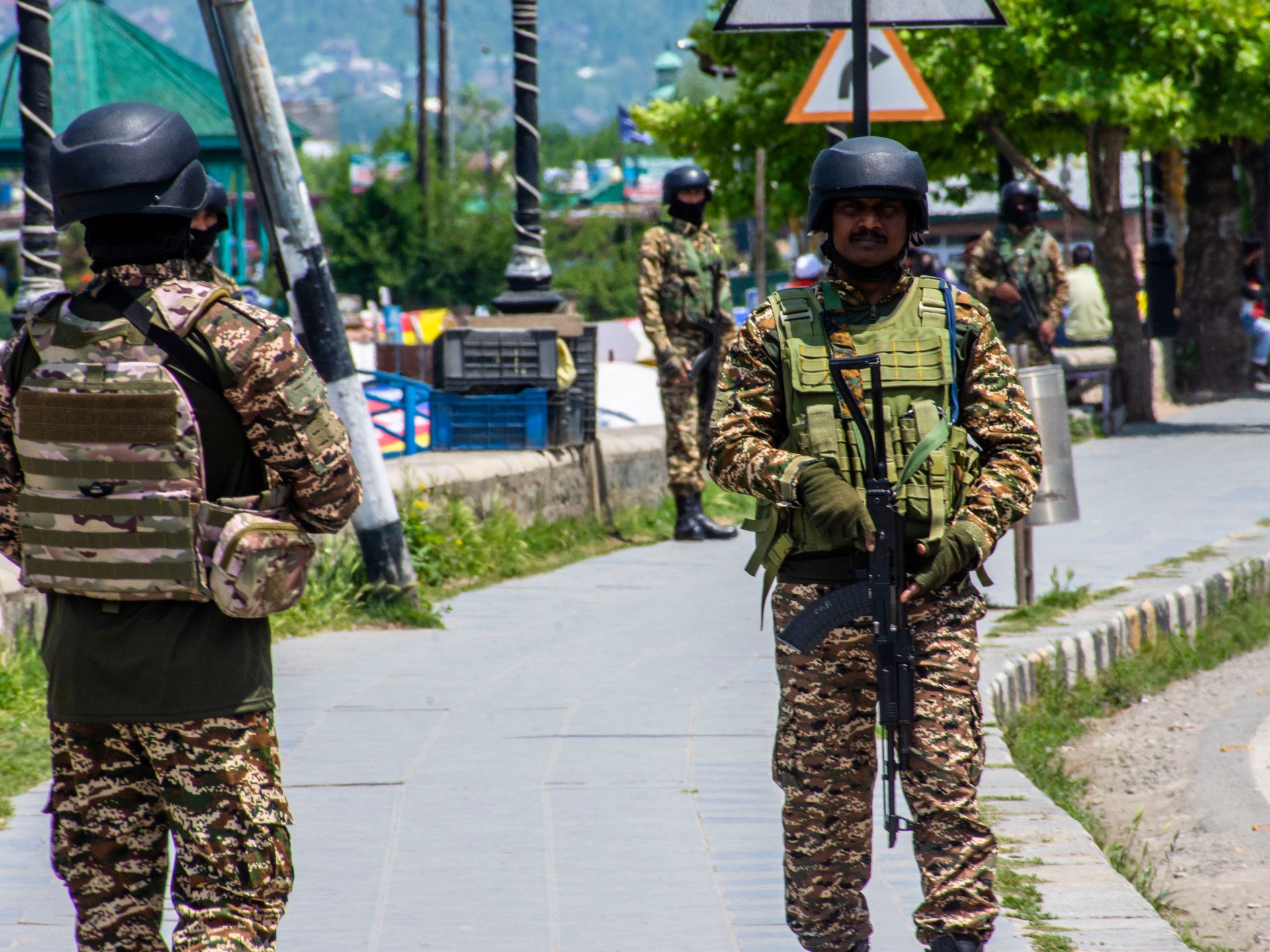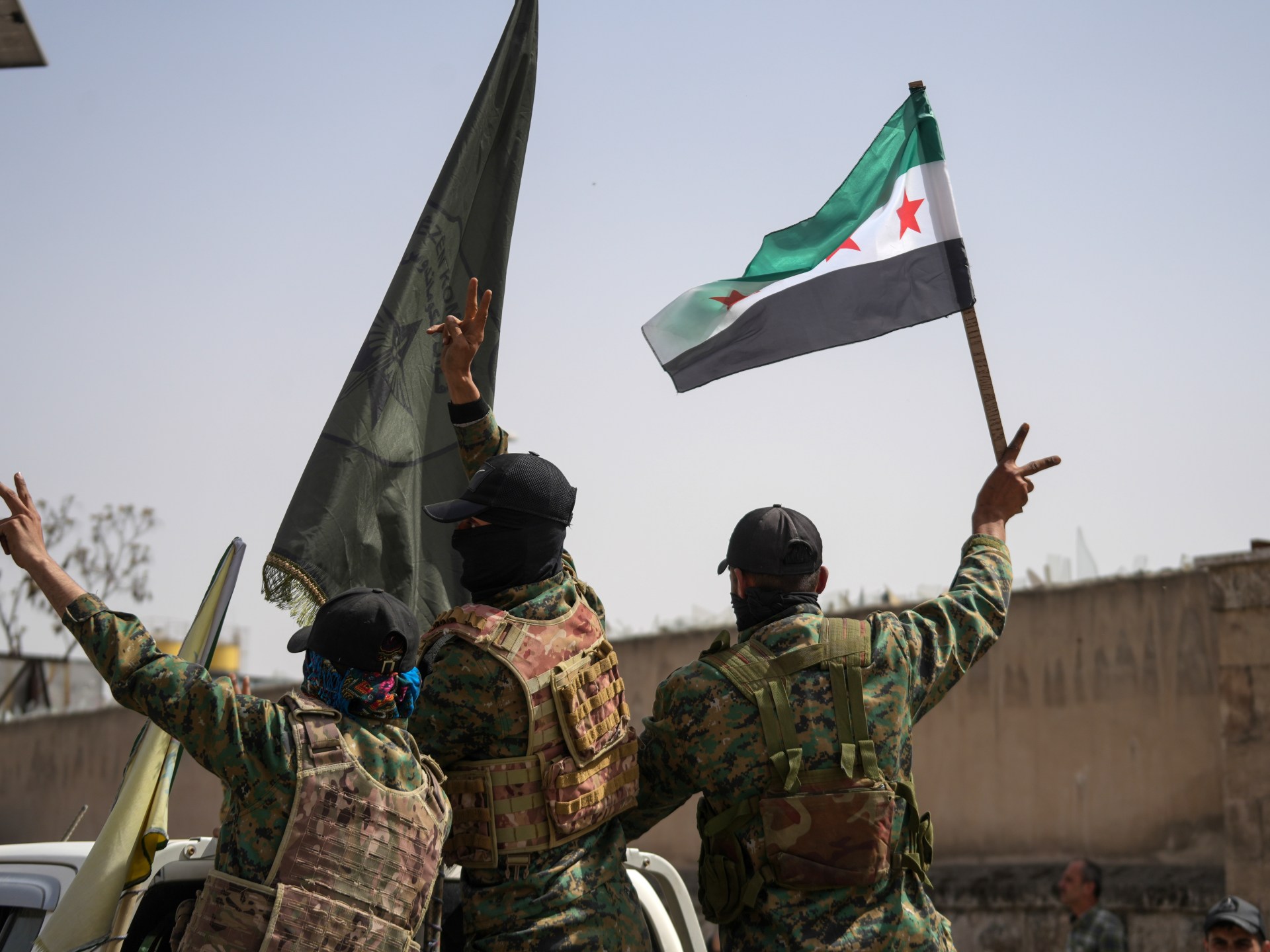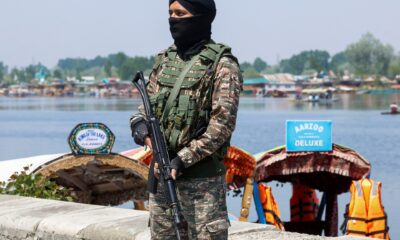Conflict Zones
India and Pakistan continue to trade fire across Kashmir border | Conflict News

Fears of wider military escalation persist following a deadly attack on resort town of Pahalgam in Indian-administered Kashmir.
India and Pakistan have exchanged gunfire for a fourth night in a row in the wake of a deadly attack on tourists in Indian-administered Kashmir last week.
The Indian army said it responded to “unprovoked small arms fire” from multiple Pakistan Army posts around midnight on Sunday along the 740km (460-mile) de-facto border separating the Indian and Pakistani areas of the disputed region, which both nations have claimed since their separation in 1947. The persistent cross-border skirmishes have raised fears of wider military escalation between the rival nuclear powers.
The Pakistani military has not yet commented on the latest exchange of fire. No casualties have been reported.
The skirmishes come after gunmen killed 26 people near the resort town of Pahalgam in Muslim-majority Kashmir last Tuesday. It was the deadliest attack on civilians in Indian-administered Kashmir for a quarter of a century.
Security officials and survivors said that gunmen segregated men during the attack, asking their names and targeting Hindus before shooting them at close range.
The attack triggered outrage and grief in India, with New Delhi accusing Pakistan of funding and encouraging “cross-border terrorism” in Kashmir. Islamabad has denied any role and called for a neutral probe.
Following the attack, India launched an extensive security operation, and identified two of the three suspects as Pakistani.
Security forces detained approximately 500 people for questioning and searched nearly 1,000 houses and forests, hunting for the attackers, according to a local police official cited by news agency Reuters.
The two nations have since unleashed a raft of measures against one another.
India has put the critical Indus Waters Treaty in abeyance and sealed its land border with Pakistan. Islamabad has closed its airspace to Indian airlines.
India’s defence forces have conducted several military exercises across the country since the attack. Some of these are routine preparedness drills, a defence official said.
Kashmir Resistance, also known as The Resistance Front, said in a social media post on Sunday that it “unequivocally” denies involvement in the attack.
The group stated that an earlier message that claimed responsibility was the result of a cyberattack, suggesting that it was the work of Indian intelligence.
Conflict Zones
ISIL group kills five Kurdish fighters in attack in eastern Syria | ISIL/ISIS News

Syria’s Kurdish-led Syrian Democratic Forces described the attack as ‘one of the deadliest’ against it in a while.
The ISIL (ISIS) group has killed five Kurdish fighters in an attack in eastern Syria’s Deir Az Zor, the group’s news agency has reported, underscoring concerns about its resurgence.
Farhad Shami, spokesperson for Syria’s Kurdish-led Syrian Democratic Forces (SDF), confirmed to Reuters news agency on Monday that five of its members were killed in the attack, which he described as “one of the deadliest” against the group in a while.
Deir Az Zor city was captured by ISIL in 2014, but the Syrian army retook it in 2017.
The ISIL group once controlled vast swathes of Syria and Iraq – including Raqqa, about 160km (100 miles) east of Aleppo and Mosul, in northern Iraq – imposing hardline rule over millions of people.
Former ISIL leader Abu Bakr al-Baghdadi had declared a caliphate over the two countries in 2014 before he was killed in a raid by United States special forces in northwest Syria in 2019 as the group collapsed.
At its peak, the group ruled over an area half the size of the United Kingdom and was notorious for its brutality. It beheaded civilians, slaughtered 1,700 captured Iraqi soldiers in a short period, and enslaved and raped thousands of women from the Yazidi community, one of Iraq’s oldest religious minorities.
A coalition of more than 80 countries, led by the US, was formed to fight the group in September 2014. The alliance continues to carry out raids against ISIL’s hideouts in Syria and Iraq.
The war against the group officially ended in March 2019, when US-backed and Kurdish-led fighters of the SDF captured the eastern Syrian town of Baghouz, which was the last sliver of land ISIL controlled.
The group was also defeated in Iraq in July 2017, when Iraqi forces recaptured Mosul. Three months later, ISIL suffered a major blow when the SDF took back the Syrian northern city of Raqqa, which was the group’s de facto capital.
ISIL has recently been trying to stage a comeback, continuing to recruit members and to claim responsibility for deadly attacks around the world.
Conflict Zones
Kashmir attack: Why Pakistan’s threat to suspend Simla Agreement matters | Conflict News

Islamabad, Pakistan – Tensions between India and Pakistan have soared since the April 22 attack on tourists in the scenic resort town of Pahalgam in Indian-administered Kashmir, in which at least 26 people were killed.
Both countries have announced a series of tit-for-tat measures, raising fears of a wider confrontation.
After a cabinet meeting led by Prime Minister Narendra Modi, India on Wednesday announced the suspension of the six-decade-old Indus Waters Treaty (IWT), a critical agreement that governs the use of the Indus River system, vital to both nations. It also announced the closure of its border with Pakistan, trade suspension, revocation of visas, and a reduction in Pakistani diplomats in India.
In response, Pakistan’s National Security Committee (NSC), its top civil-military decision-making body, announced similar measures, including border and airspace closures, suspension of trade, and, significantly, a threat to suspend its participation in all bilateral agreements with India, including the Simla Agreement.
Signed in 1972, the Simla Agreement forms the bedrock of India-Pakistan relations, governing the Line of Control (LoC) and outlining commitments to resolve disputes peacefully.
Pakistan’s threat to suspend the agreement marks a potentially serious escalation. But what exactly is the Simla Agreement, and what are the implications if Pakistan pulls out of it?
What is the Simla Agreement?
Seven months after the 1971 war, which India won and which led to the creation of Bangladesh, Pakistani President Zulfikar Ali Bhutto and Indian Prime Minister Indira Gandhi met in Shimla (sometimes also spelt as Simla), the hilly capital of the Indian state of Himachal Pradesh, to normalise relations.
Key points of the agreement [PDF], signed on July 2, 1972, included the peaceful settlement of disputes and resolving issues, including Kashmir, bilaterally.
It also urged respect for territorial sovereignty, integrity, political independence and noninterference in internal affairs.
One of the most important outcomes was the renaming of the Ceasefire Line, the working border between the two countries, to the Line of Control (LoC), with both sides agreeing not to change it unilaterally.
Following the 1971 war, the agreement also led to the release of more than 90,000 Pakistani prisoners of war India was holding.
“Pending the final settlement of any of the problems between the two countries, neither side shall unilaterally alter the situation, and both shall prevent the organisation, assistance or encouragement of any acts detrimental to the maintenance of peaceful and harmonious relations,” the agreement stated.

Why is Pakistan’s threat significant?
Ahmer Bilal Soofi, a leading international law expert and former legal adviser to the Pakistan government, described the Simla Agreement as an interim but crucial framework between the two countries.
“Suspending the agreement would require a meticulous internal assessment” by Pakistan to ensure that it serves the country’s interests in retaliating against India, Soofi told Al Jazeera. “Any decision must involve extreme due diligence.”
Another international law expert, Muhammad Mushtaq Ahmad of Shifa Tameer-e-Millat University, explained that India has long interpreted the Simla Agreement as superseding United Nations Security Council (UNSC) resolutions.
“India’s position is that the agreement made the Kashmir issue a purely bilateral matter, removing any need for international mediation,” Ahmad said.
The Himalayan territory has been a flashpoint between the two countries since they gained independence from British rule in 1947, with each controlling parts of Kashmir but claiming it in full. Since independence, the nuclear-armed neighbours have fought four wars, three of them over Kashmir.
Pakistan, on the other hand, maintains that the Simla Agreement reaffirmed UNSC resolutions advocating a diplomatic and political solution.
After the Modi government revoked Indian-administered Kashmir’s semi-autonomous status in 2019, Pakistan accused New Delhi of violating the Simla Agreement.
Islamabad could cite that to justify the suspension of its participation in the agreement, Ahmad said. Under the Vienna Convention on the Law of Treaties – a pact Pakistan is signatory to, but India is not – a material breach allows a country to denounce a treaty, he added.
But Indian defence analyst Ajai Shukla says if either or both countries walk out of the Simla Agreement, it would effectively represent an “open season” on the LoC.
“It could lead to both sides changing the ground position of the LoC, and they will be incentivised to use arms as there won’t be any treaty that will impose peace, which is currently in place,” the New Delhi-based analyst told Al Jazeera.
Does suspending the Simla Agreement mean war?
Despite the Simla Agreement, India and Pakistan have engaged in conflicts, including their four-decade-long joust for control of the Siachen Glacier — the world’s highest battleground — and the 1999 Kargil War.

Ahmad, the academic, said the LoC was never able to establish lasting peace.
Pakistani constitutional expert Rida Hosain argued that India had historically “misused” the Simla Agreement to its advantage.
“At the heart of Simla [Agreement] is peaceful coexistence. But India’s recent war-mongering rhetoric and blame for attacks without evidence suggest otherwise,” Hosain said, referring to India’s allegation that Pakistan was responsible for the Pahalgam attack. Pakistan has rejected the accusation and demanded that India present evidence to support its claim. Islamabad has also called for a “neutral investigation” in to the Kashmir attack.
Shukla, a former Indian Army officer, however, said a pullout by Pakistan from the Simla Agreement would not automatically amount to a declaration of war. Still, it would bring the neighbours closer to a potential military conflict.
“One does not automatically lead to another, but it does mean that both sides will no longer have guardrails of an international treaty that withholds them from engaging in armed hostilities,” he said.
What is Pakistan’s rationale?
Unlike its immediate implementation of other retaliatory measures, Pakistan has only threatened to walk out of the Simla Agreement.
According to Soofi, Pakistan’s rationale stems from a desire to return to multilateralism.
“India has used Simla to argue that Kashmir is a purely bilateral issue. Suspending it allows Pakistan to revert to UN Security Council mechanisms to internationalise the Kashmir dispute,” Soofi said.
Shukla said suspending the agreement could provide international cover for both sides to pursue their interests on the LoC in a manner not possible while adhering to the pact.
“Pakistan always sort of held to the notion that treaties like the Simla Agreement have tied its hands from pursuing its interests in places like Siachen, which Pakistan says is an example of India violating the agreement,” he said. India successfully captured the strategically located Siachen Glacier in 1984 in a military operation that Pakistan insists violated the Simla Agreement.
Meanwhile, India also feels hobbled by the agreement, Shukla said. New Delhi has long insisted that Pakistan-administered Kashmir belongs to India, and under Modi, the domestic rhetoric to militarily take back that territory has grown.
“In essence, both sides feel the agreement is not safeguarding their interests,” said Shukla.
Ahmad suggests that India’s suspension of the IWT could already constitute an act of aggression under international law, justifying self-defence measures by Pakistan. Under the IWT, India gets the waters of the Ravi, Beas and Sutlej rivers, all part of the Indus Basin. On the other hand, Pakistan is entitled to most of the water from the Indus, Jhelum and Chenab rivers.
“The water treaty underpins the lives of nearly 250 million Pakistanis. Its suspension can be seen as a hostile act,” Ahmad said.
The threat to pull out of the Simla Agreement, Ahmad said, was a “smart decision by the government to remind India, to issue them a warning of sorts”.
Conflict Zones
Manila denies China ‘dealt with’ Philippine mission to disputed reef | South China Sea News

Philippine officials say a mission visited Sandy Cay reef in the disputed South China Sea and unfurled the national flag.
The Philippines has denied a Chinese Coast Guard report that China had “dealt with” a situation involving six Filipino personnel, whom Beijing accused of illegally landing on a tiny reef in the disputed South China Sea.
Chinese Coast Guard spokesperson Liu Dejun said in a statement on Sunday evening that six personnel from the Philippines had earlier that day “illegally boarded” the Tiexian Reef, also known as Sandy Cay, despite “warnings and dissuasion” from the Chinese side.
Liu said that Chinese Coast Guard personnel then “boarded the reef and investigated and dealt with it in accordance with the law”. The statement did not provide further details on the encounter or the identities of the six people from the Philippines.
“We urge the Philippines to immediately stop its infringement,” Liu said, adding that the actions “violated China’s territorial sovereignty”.
Officials in Manila denied on Monday that China had taken over Sandy Cay or that a Philippine mission on Sunday to Sandy Cay – a reef over which sand has accumulated – was interfered with by Chinese maritime forces in the disputed area.
Sandy Cay, part of the Spratly Islands, lies near Thitu Island, also called Pag-asa and the site of a Philippine military facility.
“Philippine government officials have categorically denied that China has seized Sandy Cay or has now permanently taken over Sandy Cay in the South China Sea, describing the statement that was released through Chinese state media over the weekend as an ‘outright lie’, as part of Beijing’s disinformation tactics,” Al Jazeera’s Barnaby Lo said, reporting from Manila in the Philippines.
“To prove this point they showed media a recent, as recent as Sunday morning actually, a mission to Sandy Cay by the Philippine Coastguard and the Philippine Navy. Showing photos and videos of the Philippine flag being unfurled on two of the three sand bars that make up Sandy Cay in the South China Sea,” Lo said.
Lo said Philippine officials confirmed that Chinese vessels were present near the disputed reef during the mission on Sunday, but denied that the Philippine mission was “dealt with” as claimed by China.
Chinese state media said on Saturday that the country’s coastguard had “implemented maritime control” over the Tiexian Reef during the middle of April. China’s state broadcaster CCTV said in the report that the Chinese coastguard landed on Sandy Cay to “exercise sovereignty and jurisdiction” over the reef, carry out an “inspection” and “collect video evidence regarding the illegal activities of the Philippine side”.
The broadcaster published a photograph of five people, clad in black, standing on the uninhabited reef as a dark inflatable boat bobbed in the nearby water. Another shot showed four coastguard officials posing with a national flag on the reef’s white surface, in what CCTV described as a “vow of sovereignty”.
According to reports, there is no sign that China has permanently occupied the reef.
Also on Monday, the Philippine and US militaries launched three weeks of annual joint exercises, called “Balikatan” or “shoulder to shoulder”, which will include an integrated air and missile defence simulation for the first time.
Beijing has said the manoeuvres “undermine regional strategic stability” and accused Manila of “collusion with countries outside the region”.
Al Jazeera’s Katrina Yu, reporting from Beijing, said the unfurling of a Chinese flag by the coastguard on Sandy Cay was significant in terms of stating claim to the reef, and the timing in advance of the annual US-Philippine military exercises.
“So it seems that with the staking of this Chinese flag on this reef, it is sending a message not only to Manila but also to Washington,” Yu said.
-

 Europe1 day ago
Europe1 day agoLiverpool secures historic Premier League title after beating Tottenham
-

 Europe1 day ago
Europe1 day agoFrancis celebrated as ‘pope among the people’ in Vatican funeral attended by massive crowd
-

 Africa2 days ago
Africa2 days agoUganda declares end to Ebola outbreak
-

 Europe1 day ago
Europe1 day agoTrump and Zelensky hold war talks inside St. Peter’s Basilica ahead of pope’s funeral
-

 Middle East1 day ago
Middle East1 day agoSaudi Arabia, Qatar to settle Syria’s outstanding debt to World Bank | Business and Economy News
-

 Lifestyle18 hours ago
Lifestyle18 hours agoHow bugs and beet juice could play roles in the race to replace artificial dyes in food
-

 Conflict Zones16 hours ago
Conflict Zones16 hours ago‘Burst balloon’: How Pahalgam attack shattered Modi’s Kashmir narrative | Narendra Modi News
-

 Sports1 day ago
Sports1 day agoNew England Patriots make Kobee Minor this year’s ‘Mr. Irrelevant’




